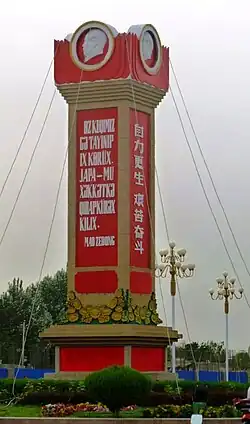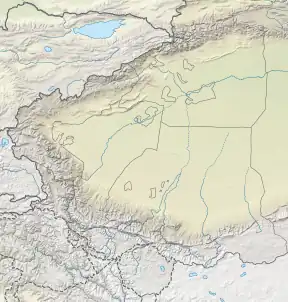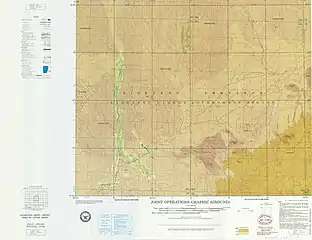Niya Town
Niya (Uyghur: نىيە Нийә; Chinese: 尼雅; pinyin: Níyǎ), is a town in Minfeng County, Hotan Prefecture, Xinjiang Uygur Autonomous Region, China.
Niya
نىيە 尼雅 | |
|---|---|
Town | |
 Monument in downtown Minfeng | |
 Niya Location in Xinjiang | |
| Coordinates: 37°03′N 82°41′E | |
| Country | People's Republic of China |
| Region | Xinjiang |
| Prefecture | Hotan |
| County | Minfeng/Niya |
| Elevation | 1,405 m (4,610 ft) |
| Population (2010)[1] | |
| • Total | 3,486 |
| Time zone | UTC+8 (China Standard) |
| Postal code | 848500 |
It is the county seat of Minfeng County, and therefore is commonly referred to as Minfeng, and is labeled so on less detailed maps. An ancient town also called Niya is located 115 km to the north of this modern Niya.
Name
The former name for the Niya region was Nina.[2] The word seems to be related to the Greek word nimma (Greek: νίμμα), meaning "pure water".[2] During the Han dynasty, the city was known as Jingjue. This word's Chinese characters mean "pure" or "clean", implying a relation between the two names.[2]
History
Niya/Minfeng was known in ancient time as Ronglu (戎盧) during the Han dynasties (206 BC - 222 AD)[3] and, according to the Hanshu Chapter 96A, was said to have had "240 households, 610 individuals with 300 persons able to bear arms" during the Former Han Dynasty (206 BC - 23 AD).[4] It is situated about 115 km north of the modern town of Minfeng. Numerous Buddhist scriptures, sculptures, mummies and other precious archeological finds have been made in the region. The remains of more than seventy buildings have been discovered scattered over an area of some 45 km2. It was located on the southern branch of the Silk Road.[5]
In the early 20th century, Aurel Stein carried out several expeditions in the area including exploration of the ancient Niya ruins. In 1991, a joint Sino-Japanese expedition dug up the ancient city and established that the original inhabitants of the city may have been members of Alexander the Great's army, settling in the city during Alexander's conquests.[6]
In 2015, Lanpalu was added as a residential community.[7]
In 2017, Ankang, Xingfu, Tuanjie, Hexie, Guangming and Youyi were established as residential communities.[8]
Geography

Niya is located on China National Highway 315, which is the main Ruoqiang-Hotan road along the southern edge of the Tarim Basin.
It is situated 120 km east of Keriya, and about 330 km west of Qiemo (Cherchen). Human habitation in the area is possible because of the Niya River, fed by the snows and glaciers of the Kunlun.
Niya is a small town of about 10,000 people with a small market, shops, many restaurants, and a hotel.
Administrative divisions
As of 2018, the county includes ten residential communities and two villages:[9][10]
Residential communities (Mandarin Chinese Hanyu Pinyin-derived names):
- Bositanlu (博斯坦路居民委员会), Maidiniyetilu (买迪尼也提路居民委员会), Suodalu (索达路居民委员会), Lanpalu (兰帕路居民委员会), Ankang (安康社区居民委员会), Xingfu (幸福社区居民委员会), Tuanjie (团结社区居民委员会), Hexie (和谐社区居民委员会), Guangming (光明社区居民委员会), Youyi (友谊社区居民委员会)
Villages:
- Lanpa (兰帕村委会), Fufuke (甫甫克村委会)
In 2009, the county included:[11]
Residential communities (Mandarin Chinese Hanyu Pinyin-derived names):
- Bositanlu (博斯坦路居民委员会), Maidiniyetilu (买迪尼也提路居民委员会), Suodalu (索达路居民委员会)
Villages:
- Lanpa (兰帕村委会), Fufuke (甫甫克村委会)
Demographics
| Year | Pop. | ±% p.a. |
|---|---|---|
| 2000 | 9,684 | — |
| 2010 | 3,486 | −9.71% |
| [1] | ||
The population of Niya Town proper declined between the 2000 and 2010 Census.
Transportation
- China National Highway 315
- Minfeng railway station serving the Hotan–Ruoqiang railway
References
- 民丰县历史沿革 [Minfeng County Historical Development] (in Simplified Chinese). XZQH.org. 2 December 2014. Retrieved 8 December 2019.
2000年第五次人口普查,民丰县常住总人口32111人,其中:尼雅镇9684人、尼雅乡5803人、{...}2010年第六次人口普查,民丰县常住总人口33932人,其中:尼雅镇3486人,尼雅乡6373人,
- Christopoulos, Lucas (August 2021). "Hellenes and Romans in Ancient China" (PDF). Sino-Platonic Papers. 230: 16–17.
- Hill (2015) Vol. I, p. 82, n. 1.12.
- Hulsewé, A. F. P. and Loewe, M. A. N. 1979. China in Central Asia: The Early Stage 125 BC – AD 23: an annotated translation of chapters 61 and 96 of the History of the Former Han Dynasty. E. J. Brill, Leiden. ISBN 90-04-05884-2; p. 92.
- Baumer, Christoph. Southern Silk Road: In the Footsteps of Sir Aurel Stein and Sven Hedin. Christoph Baumer. 2000. Bangkok. White Orchid Books, p. 100.
- Schmetzer, Uli (21 November 1993). "LOST CHINA CITY LINKED TO ALEXANDER". Chicago Tribune. Retrieved 2023-03-25.
- 2015年统计用区划代码和城乡划分代码:尼雅镇 [2015 Statistical Area Numbers and Rural-Urban Area Numbers: Niya Town] (in Simplified Chinese). National Bureau of Statistics of the People's Republic of China. 2015. Retrieved 14 January 2020.
代码 城乡分类 名称 653227100001 121 博斯坦路居民委员会 653227100002 121 买迪尼也提路居民委员会 653227100003 121 索达路居民委员会 653227100004 121 兰帕路居民委员会 653227100200 122 兰帕村委会 653227100201 122 甫甫克村委会
- 2017年统计用区划代码和城乡划分代码:尼雅镇 [2017 Statistical Area Numbers and Rural-Urban Area Numbers: Niya Town] (in Simplified Chinese). National Bureau of Statistics of the People's Republic of China. 2017. Retrieved 14 January 2020.
统计用区划代码 城乡分类代码 名称 653227100001 121 博斯坦路居民委员会 653227100002 121 买迪尼也提路居民委员会 653227100003 121 索达路居民委员会 653227100004 121 兰帕路居民委员会 653227100005 121 安康社区居民委员会 653227100006 121 幸福社区居民委员会 653227100007 121 团结社区居民委员会 653227100008 121 和谐社区居民委员会 653227100009 122 光明社区居民委员会 653227100010 121 友谊社区居民委员会 653227100200 122 兰帕村委会 653227100201 122 甫甫克村委会
- 2009年民丰县行政区划 [2009 Minfeng County Administrative Divisions] (in Simplified Chinese). XZQH.org. 6 January 2011. Retrieved 11 January 2020.
行政区划代码及城乡划分代码 653227 民丰县 653227100 尼雅镇 653227100001 121 博斯坦路居委会 653227100002 121 买迪尼也提路居委会 653227100003 121 索达路居委会 653227100200 122 兰帕村 653227100201 122 甫甫克村
- 2018年统计用区划代码和城乡划分代码:尼雅镇 [2018 Statistical Area Numbers and Rural-Urban Area Numbers: Niya Town] (in Simplified Chinese). National Bureau of Statistics of the People's Republic of China. 2018. Retrieved 11 January 2020.
统计用区划代码 城乡分类代码 名称 653227100001 121 博斯坦路居民委员会 653227100002 121 买迪尼也提路居民委员会 653227100003 121 索达路居民委员会 653227100004 121 兰帕路居民委员会 653227100005 121 安康社区居民委员会 653227100006 121 幸福社区居民委员会 653227100007 121 团结社区居民委员会 653227100008 121 和谐社区居民委员会 653227100009 122 光明社区居民委员会 653227100010 121 友谊社区居民委员会 653227100200 122 兰帕村委会 653227100201 122 甫甫克村委会
- 2009年统计用区划代码和城乡划分代码:尼雅镇 [2009 Statistical Area Numbers and Rural-Urban Area Numbers: Niya Town] (in Simplified Chinese). National Bureau of Statistics of the People's Republic of China. 2009. Retrieved 14 January 2020.
代码 城乡分类 名称 653227100001 121 博斯坦路居民委员会 653227100002 121 买迪尼也提路居民委员会 653227100003 121 索达路居民委员会 653227100200 122 兰帕村委会 653227100201
Further reading
- Bonavia, Judy 2004. The Silk Road From Xi’an to Kashgar. Revised by Christoph Baumer. 2004. Odyssey Publications. ISBN 962-217-741-7
- Mallory, J. P. and Mair, Victor H. 2000. The Tarim Mummies: Ancient China and the Mystery of the Earliest Peoples from the West. Thames & Hudson. London. 2000.
- Stein, M. Aurel 1907. Ancient Khotan: Detailed report of archaeological explorations in Chinese Turkestan, 2 vols. Oxford. Clarendon Press.
- Stein, M. Aurel 1912. Ruins of Desert Cathay: Personal narrative of explorations in Central Asia and westernmost China, 2 vols. Reprint: Delhi. Low Price Publications. 1990.
- Stein, M. Aurel 1921. Serindia: Detailed report of explorations in Central Asia and westernmost China, 5 vols. London. Oxford. Clarendon Press. Reprint: Delhi. Motilal Banarsidass. 1980.
- Yu, Taishan. 2004. A History of the Relationships between the Western and Eastern Han, Wei, Jin, Northern and Southern Dynasties and the Western Regions. Sino-Platonic Papers No. 131 March, 2004. Dept. of East Asian Languages and Civilizations, University of Pennsylvania.